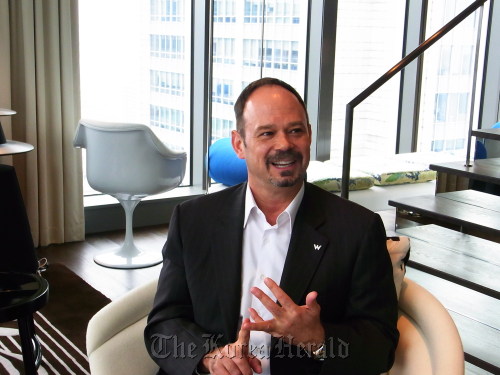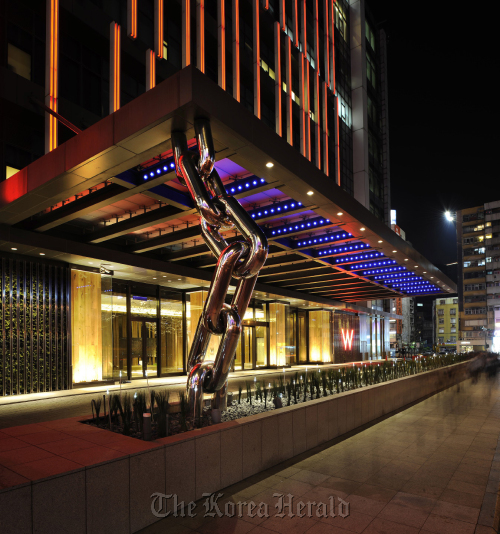Manager says Taiwan’s first W hotel aims to exceed 45 percent occupancy rate this year
TAIPEI ― In the bustling central business district of Xinyi in Taipei, W Taipei hotel encased in radiant glass stands tall not far from the iconic 101 Tower which shoots up more than 500 meters into the sky.
Arriving at the first W hotel in Taiwan, a large stainless steel installation called “The Chain” is seen, which symbolically anchors the W Taipei building to Taipei city.
Officially opened in February, the hotel has breathed new life not only to the lifestyle of people in the city but to the local hospitality industry, said the hotel’s general manager.
“Taipei did not have any hotel opening in the past 12 years. This market was gasping for breath,” said Cary Michael Gray, general manager of W Taipei, in an interview with The Korea Herald.
“People take more films and pictures here (in the hotel). The biggest comment from our guests is ‘I can’t get a reservation,’” said Gray, referring to the popularity of the hotel’s two restaurants and three bars.
TAIPEI ― In the bustling central business district of Xinyi in Taipei, W Taipei hotel encased in radiant glass stands tall not far from the iconic 101 Tower which shoots up more than 500 meters into the sky.
Arriving at the first W hotel in Taiwan, a large stainless steel installation called “The Chain” is seen, which symbolically anchors the W Taipei building to Taipei city.
Officially opened in February, the hotel has breathed new life not only to the lifestyle of people in the city but to the local hospitality industry, said the hotel’s general manager.
“Taipei did not have any hotel opening in the past 12 years. This market was gasping for breath,” said Cary Michael Gray, general manager of W Taipei, in an interview with The Korea Herald.
“People take more films and pictures here (in the hotel). The biggest comment from our guests is ‘I can’t get a reservation,’” said Gray, referring to the popularity of the hotel’s two restaurants and three bars.


Because a new hotel development had long been stunted in Taipei, young people looking for a career in the hospitality industry realized that key positions were already taken.
With W Taipei, however, Gray added 450 people on board. Among them, 43 were Taiwan-born people who were working overseas but came back to Taipei, Gray said.
“So, we’ve given a breath of air into this whole industry.”
The hotel’s key concept is “Nature Electrified,” combining the city’s natural setting surrounded by mountain ranges with the energy and electrification of the busy urban Taipei, he said.
Entering the building, an interactive light installation “To Light You Fade,” designed by rAndom International, welcomes you at the lobby and another artwork “Purple Target,” a canvas filled with thumbtacks, hangs on the wall beside the elevators.
Taking the elevator to the 10th floor, you will find check-in desks, W Taipei’s signature Woo Bar, the Living Room, the buffet restaurant Kitchen Table and the WET pool skydeck.
High atop on the 31st floor, the hotel’s signature Cantonese restaurant YEN is located. As the first Chinese restaurant in W hotels in the world, its strongest appeal is a fantastic view of the Taipei 101 building.
Private dining rooms at the YEN have to be reserved three weeks to one month in advance, Gray said.
What surprised him was that the No. 1 source of business for the rooms were Taiwanese.
W Taipei’s 405 guestrooms and suites were designed by London-based G.A. Design International. The Fabulous Room is priced at about $700 per night including tax and service charges. In-room features include high-speed wired and wireless Internet access, a 42-inch LCD TV set, Bose sound system and iPod charging docks.
W Taipei also has the largest pillar-less ballroom in the city, The Mega Room, for meetings, gala wedding banquets and fashion shows.
As much as the hotel is becoming more known to local people in Taipei, the hotel aims to increase its occupancy rate over 45 percent this year, he said.
“Best hotels out of 12 in Asia that opened in the past two years had an average 42 percent in occupancy rate in their first year,” Gray said, adding that an average occupancy rate among five-star hotels in Taipei is about 70 percent.
Opening a hotel needs more coordination and integration of the product and the service than opening other kinds of buildings such as a residence or office building, and it takes about at least eight months for a hotel to modify every detail of the service, he said.
“There are so many things that could be irritating to guests that you can’t really see until you go and live in there,” he said.
By Kim Yoon-mi, Korea Herald correspondent
(yoonmi@heraldcorp.com)



![[AtoZ into Korean mind] Humor in Korea: Navigating the line between what's funny and not](http://res.heraldm.com/phpwas/restmb_idxmake.php?idx=644&simg=/content/image/2024/04/22/20240422050642_0.jpg&u=)
![[Exclusive] Korean military set to ban iPhones over 'security' concerns](http://res.heraldm.com/phpwas/restmb_idxmake.php?idx=644&simg=/content/image/2024/04/23/20240423050599_0.jpg&u=20240423183955)



![[Graphic News] 77% of young Koreans still financially dependent](http://res.heraldm.com/phpwas/restmb_idxmake.php?idx=644&simg=/content/image/2024/04/22/20240422050762_0.gif&u=)
![[Herald Interview] Why Toss invited hackers to penetrate its system](http://res.heraldm.com/phpwas/restmb_idxmake.php?idx=644&simg=/content/image/2024/04/22/20240422050569_0.jpg&u=20240422150649)





![[Exclusive] Korean military to ban iPhones over security issues](http://res.heraldm.com/phpwas/restmb_idxmake.php?idx=652&simg=/content/image/2024/04/23/20240423050599_0.jpg&u=20240423183955)



![[Today’s K-pop] Ateez confirms US tour details](http://res.heraldm.com/phpwas/restmb_idxmake.php?idx=642&simg=/content/image/2024/04/23/20240423050700_0.jpg&u=)